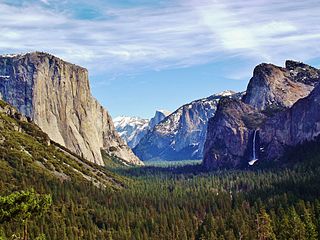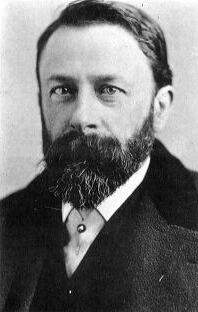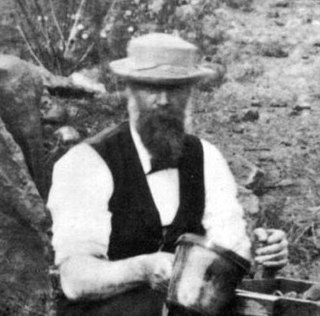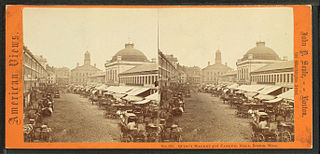Gallery
- Emma Metcalf, photograph by Charles L. Weed, 1865.
- One of 30 mammoth-plate albumen prints of Yosemite Valley, and the Big Trees, Calaveras County, California taken in 1864 by Charles Leander Weed
Charles Leander Weed was an American photographer, who was born in New York state on July 17, 1824, and died in Oakland, California on August 31, 1903. [1] He is perhaps best known for being one of the earliest photographers, if not the first photographer, to enter and photograph what is now Yosemite National Park. [2] [3]
In 1854, during the California Gold Rush, Weed moved to Sacramento, California, and was a camera operator in the daguerreotype portrait studio of George J. Watson. In 1855, Weed adopted the wet collodion technique, and his photographs of Gold Rush miners and settlement were much admired. [1]
Entrepreneur James Hutchings and others ventured into the area of what is now known as Yosemite Valley in 1855, becoming the Valley's first tourists. After returning to Mariposa Hutchings wrote an article about his experience which appeared in the August 9, 1855 issue of the Mariposa Gazette and was later published in various forms nationally. [4]
Hutchings brought Weed to the Valley in the summer of 1859. [1] Weed took the first known photographs of the Valley's features, and a September exhibition in San Francisco presented them to the public. Hutchings published four installments of "The Great Yo-semite Valley" from October 1859 [5] to March 1860 in his magazine; these articles contained woodcuts based on Weed's photographs. A book by Hutchings titled Scenes of Wonder and Curiosity in California collected these articles and the book stayed in print well into the 1870s. [6]
Beginning in 1860, Weed started extensive traveling, including trips to Hong Kong (where he briefly established a studio) and Hawaii. [7] During his travels, he also visited Shanghai and Japan. He made two separate trips to Japan, one in 1867 and another in 1868. [8] He is believed to be the first photographer to use a mammoth camera in Japan, and took photographs of Nagasaki, Edo, Yokohama and Kamakura. There are currently 72 of Weed's photographs of Japan known to survive, including 32 in public collections in Japan (20 half-stereo photographs at the Yokohama Archives of History; 3 mammoth size at Nihon University; and 9 stereo photographs at JCII Camera Museum), 31 portfolio size in a private collection in Japan (Okayama Yoji collection), and 9 in public collections outside of Japan (7 at the Canadian Centre for Architecture, all mammoth size; 2 at the Freer Gallery of Art, mammoth size; and 1 at the Wilson Centre for Photography, London, mammoth size). An exhibition of Weed's photographs of Japan was organized at the Yokohama Archives of History Jan. 28-March 12, 2023. There is an exhibition catalog.
Weed presented his work at the Paris Exposition Universelle, where he won an award for landscape photography. [1]
In 1872, Weed made another visit to Yosemite, probably in the company of well-known Yosemite photographer Eadweard Muybridge. Weed concluded his career by working as a photoengraver. [1]
Charles Leander Weed was born 1824 in Conesus, Livingston or Elmira, New York, the son of Royal Newland Weed and Ruth Austin. He married Sarah P. Irish on May 1, 1876, in Oakland, Alameda, California. He died August 31, 1903. Both are buried in Oakland. They had one known child Mary E Weed. [9]

Yosemite National Park is an American national park in California, surrounded on the southeast by Sierra National Forest and on the northwest by Stanislaus National Forest. The park is managed by the National Park Service and covers an area of 759,620 acres in four counties – centered in Tuolumne and Mariposa, extending north and east to Mono and south to Madera County. Designated a World Heritage Site in 1984, Yosemite is internationally recognized for its cliffs, waterfalls, clear streams, giant sequoia groves, lakes, mountains, meadows, glaciers, and biological diversity. Almost 95 percent of the park is designated wilderness. Yosemite is one of the largest and least fragmented habitat blocks in the Sierra Nevada, and the park supports a diversity of plants and animals.

Yosemite Valley is a glacial valley in Yosemite National Park in the western Sierra Nevada mountains of Central California. The valley is about 7.5 mi (12.1 km) long and 3,000–3,500 ft (910–1,070 m) deep, surrounded by high granite summits such as Half Dome and El Capitan, and densely forested with pines. The valley is drained by the Merced River, and a multitude of streams and waterfalls flow into it, including Tenaya, Illilouette, Yosemite and Bridalveil Creeks. Yosemite Falls is the highest waterfall in North America and is a big attraction especially in the spring, when the water flow is at its peak. The valley is renowned for its natural environment and is regarded as the centerpiece of Yosemite National Park.

Eadweard Muybridge was an English photographer known for his pioneering work in photographic studies of motion, and early work in motion-picture projection. He adopted the first name "Eadweard" as the original Anglo-Saxon form of "Edward", and the surname "Muybridge", believing it to be similarly archaic.

Ansel Easton Adams was an American landscape photographer and environmentalist known for his black-and-white images of the American West. He helped found Group f/64, an association of photographers advocating "pure" photography which favored sharp focus and the use of the full tonal range of a photograph. He and Fred Archer developed an exacting system of image-making called the Zone System, a method of achieving a desired final print through a deeply technical understanding of how tonal range is recorded and developed during exposure, negative development, and printing. The resulting clarity and depth of such images characterized his photography.

Albert Bierstadt was a German-American painter best known for his lavish, sweeping landscapes of the American West. He joined several journeys of the Westward Expansion to paint the scenes. He was not the first artist to record the sites, but he was the foremost painter of them for the remainder of the 19th century.

Carleton E. Watkins (1829–1916) was an American photographer of the 19th century. Born in New York, he moved to California and quickly became interested in photography. He focused mainly on landscape photography, and Yosemite Valley was a favorite subject of his. His photographs of the valley significantly influenced the United States Congress' decision to preserve it as a National Park.

Human habitation in the Sierra Nevada region of California reaches back 8,000 to 10,000 years ago. Historically attested Native American populations, such as the Sierra Miwok, Mono and Paiute, belong to the Uto-Aztecan and Utian phyla. In the mid-19th century, a band of Native Americans called the Ahwahnechee lived in Yosemite Valley. The California Gold Rush greatly increased the number of non-indigenous people in the region. Tensions between Native Americans and white settlers escalated into the Mariposa War. As part of this conflict, settler James Savage led the Mariposa Battalion into Yosemite Valley in 1851, in pursuit of Ahwaneechees led by Chief Tenaya. The California state military forces burned the tribe's villages, destroyed their food stores, killed the chief's sons, and forced the tribe out of Yosemite. Accounts from the Mariposa Battalion, especially from Dr. Lafayette Bunnell, popularized Yosemite Valley as a scenic wonder.

James Mason Hutchings was an American businessman and one of the principal promoters of what is now Yosemite National Park.

George Fiske was an American landscape photographer.

Arthur Clarence Pillsbury (1870–1946) was a United States photographer, inventor, and filmmaker, known through his innovations which extended human vision at a critical time in our history. Although many make the mistake of focusing on his sensational landscapes of Yosemite National Park, photos of the 1906 San Francisco earthquake, and time lapse photography of flowers, he had seen the potential of film for rapidly increasing our understanding in every part of science.

Anne Wardrope Brigman was an American photographer and one of the original members of the Photo-Secession movement in America.

Mother of the Forest was a giant sequoia in the Sierra Nevada that was stripped of its bark and used as an exhibition tree. Discovered in 1852 by Augustus T. Dowd, it was the second largest tree in Calaveras Grove, standing at 328 feet tall with a circumference of 93 feet. During the California Gold Rush, its bark was harvested and exhibited in New York and London. However, the remaining tree was eventually destroyed by fire in 1908, leaving only a fire-blackened snag.

John Payson Soule (1828–1904) was a photographer and publisher in Boston, Massachusetts, and Seattle, Washington.
California Tonalism was art movement that existed in California from circa 1890 to 1920. Tonalist are usually intimate works, painted with a limited palette. Tonalist paintings are softly expressive, suggestive rather than detailed, often depicting the landscape at twilight or evening, when there is an absence of contrast. Tonalist paintings could also be figurative, but in them, the figure was usually out of doors or in an interior in a low-key setting with little detail.
Leo Millard Holub was an American photographer famous for his landscapes and architectural images of San Francisco, and photographs of Yosemite. His contemporaries and close friends included Ansel Adams and Imogen Cunningham.
Charles Dorman Robinson was an American panorama, cyclorama, landscape, and marine painter. He is known for his seascapes and landscapes of Northern California, including over a hundred paintings of Yosemite Valley. He was known as "the dean of Pacific Coast artists".

Hutchings' Illustrated California Magazine was a magazine published between 1856 and 1861, in San Francisco, which played an important role in popularizing California in general, and to a large extent Yosemite National Park in particular.
Martin Mason Hazeltine (1827–1903) was an American photographer. Hazeltine specialized in stereography, creating one of the largest collections of scenic landscape photography of the American West dating to the 1860s and 1870s.
Yosemite Cemetery, also known as Pioneer Cemetery, is a cemetery built in the 1870s and located on the west end of Yosemite Village, in Mariposa County, California. In 2014, the Yosemite Conservancy worked in restoring the cemetery and graves. Many of the graves are from the earliest European-descent pioneers, and a few of the graves were for Native Americans that had lived in the valley.

Florence Hutchings was the daughter of James Mason Hutchings and his wife Elvira. She lived a short but colorful life.